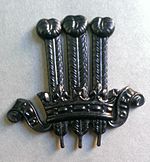2nd Gurkha Rifles
| 2nd King Edward VII's Own Gurkha Rifles | |
|---|---|

Cap badge of the 2 Gurkha Rifles
|
|
| Active | 1815–1994 |
| Country |
|
| Branch | British Army |
| Type | Infantry |
| Role | Light Infantry |
| Garrison/HQ | British Hong Kong |
| Nickname(s) | The Sirmoor Rifles, Second (2nd) GR |
| Colors | Green; faced and piped red, 1888 scarlet |
| March | Lutzow's Wild Chase(Quick March) |
| Commanders | |
| Colonel in Chief | HRH The Prince of Wales |
| Notable commanders |
Lieutenant-Colonel Begbie Major General D Macintyre VC Colonel H T Macpherson VC Subadar-Major Santbir Gurung Lieutenant-Colonel Frederick William Nicolay |
| Insignia | |
| Shoulder Flash | |
| Abbreviation | 2 GR |
The 2nd King Edward VII's Own Gurkha Rifles (The Sirmoor Rifles) was a rifle regiment of the British Indian Army before being transferred to the British Army comprising Gurkha soldiers of Nepalese origin on India's independence in 1947. The 4th Battalion joined the Indian Army as the 5th Battalion, 8th Gurkha Rifles (Sirmoor Rifles), where it exists to this day. As part of the British Army, the regiment served in Malaya, Hong Kong and Brunei until 1994 when it was amalgamated with the other three British Army Gurkha regiments to form the Royal Gurkha Rifles. It is the only Gurkha regiment which did not have Khukuri on its cap badge.
The regiment was first raised in 1815 as The Sirmoor Battalion. This was the first Gurkha unit in the service of the East India Company to see action, during the 3rd Mahratta War in 1817. The regiment, by now named the 8th (Sirmoor) Local Battalion, gained its first battle honour at Bhurtpore in 1825. During the First Sikh War, the regiment fought at Bhudaiwal and Sobraon, as well as the Battle of Aliwal. Personnel carried colours at the time, and the flagpole was broken by cannon fire. The colour itself was seized by the Sikhs but reclaimed by a small party of Gurkhas led by a Havildar who chopped their way into the densely packed enemy lines.
During the Indian Mutiny, the Sirmoor Battalion was one of the Indian regiments that remained loyal to Britain. It was during this that the regiment took part in the defence of Hindu Rao's House, near Delhi. For their part in the action, the Sirmoor Battalion was presented with the Queen's Truncheon, which became a replacement for the colours that they relinquished when the regiment became a rifle regiment in 1858. With the decision to number the Gurkha regiments in 1861, the Sirmoor Rifles became the 2nd Gúrkha Regiment. In 1876, which then acquired a royal patron in the then Prince of Wales, becoming the 2nd (Prince of Wales's Own) Gúrkha Regiment (the Sirmoor Rifles).
...
Wikipedia
